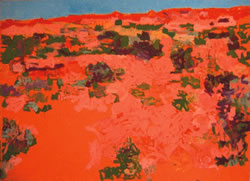Artist of the Month - February 2006 An Original
Brandt |
|||||
Most people’s perception of the
quintessential artist results from the histories of legendary
painters whose eccentricities walked the thin line between
genius and madness. My own experience in meeting artists
has led me to conclude that most artists lead fairly mainstream
lives and perceive the world fairly similarly to those of
us who neither paint, sculpt, write nor compose. The difference
between us and them is boiled down to having the tools to
record and explore the reality most of us agree on.
Brandt’s eyes come alive and bright
when he discusses his paintings, much like a proud mother’s
watching her child behave. And his work deserves such admiration,
both from the painter and the critic, because within it he
captures the best of his intuition, his innate eye for composition
and his inner vibrancy. Brandt’s interest in drawing began
in middle school when he replicated a Rembrandt etching (“Christ
in the Temple”) in pencil. He captured the detailed
sketch with complete accuracy, down to every stroke. His
style has evolved greatly over the years, from detailed pencil
drawings to the abstract oils he currently creates.
This ability to focus bordering on the
obsessive is part of what makes Brandt such an intriguing
personality. Painting and recovery are intertwined in his
mind. He explains that “the painting is teaching me
to work and how to pace myself.” In contrast to how
he painted one of his earlier works, “Orange Jubilee,” on
which he spent an entire week with few breaks and felt wiped
out at the end, he now realizes that he “needs rest
to produce good paintings.”
In contrast to his conversation which
roams and is liberally sprinkled with allusions to the Bible
or esoteric references, his paintings are made up of quick
decisive strokes. He creates angular lines that evoke a cubist
look. The hand holding the brush seems to move with purpose,
and the dried paint captures this dynamism and imbues the
painting with a sense of movement.
He uses a fairly limited palette consisting
mostly of cadmium red and orange, gold, copper, blue and
green. Interestingly, he never uses yellow or burnt umber,
two colors that naturally appear so abundantly in the landscapes
he often depicts. This irony seems to reflect how Brandt
is not tied down by notions of reality, and this ability
to step outside these bounds is what liberates him into creating
moving abstracts that appeal to the eye and to the mind. |




